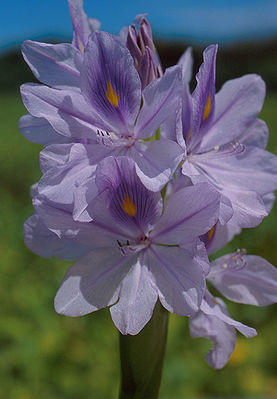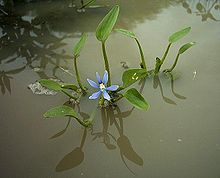Water hyacinth family
| Water hyacinth family | ||||||||||||
|---|---|---|---|---|---|---|---|---|---|---|---|---|

Thick-stemmed water hyacinth ( Eichhornia crassipes ), inflorescence |
||||||||||||
| Systematics | ||||||||||||
|
||||||||||||
| Scientific name | ||||||||||||
| Pontederiaceae | ||||||||||||
| Kunth |
The pontederiaceae or Hecht herb plants (Pontederiaceae) are a family in the order of the Commelina-like (Commelinales) within the monocotyledonous plants ( monocots ). These marsh or water plants have an almost worldwide distribution; some species are invasive plants in the tropics .
Description and ecology
Appearance and leaves


They are herbaceous plants , mostly persistent , but there are also annual species. The plants are more or less succulent . These aquatic or marsh plants are free-flowing (floating) or anchored in the ground with roots. Stems or petioles are often spongy on the inside to trap air for better swimming ability.
The leaves are all distributed on the base of the shoot or on the stem. They are usually alternate and spiral or two-line, less often arranged in whorls. The leaves can be submerged (submerged) or above water (emersed) (depending on the species). Most genera have well-developed leaves, with Hydrothrix the leaves are greatly reduced. The leaves are simple and stalked with tubular leaf sheaths. The mostly simple leaf blades are shaped very differently and have parallel to network nerves. The leaf margin is smooth. Only with Hydrothrix is the leaf blade broken up into uneven thread-like strands. The stomata are paracytic.
Inflorescences and flowers
The flowers stand alone or in differently structured inflorescences . Often two are bracts (bracts) available.
The small to medium-sized flowers are hermaphroditic , threefold and radially symmetrical to strongly zygomorphic . There are two circles with three bracts each; they are of the same or distinctly different shape and are free or fused at their base. All bracts of a flower have the same color: white, purple, blue or rarely yellow. There are one or mostly two circles with three free stamens each; they are the same to significantly different. Either all of the stamens are fertile or two to three are transformed into staminodes . For example with Hydrothrix there is only one fertile stamen. The three carpels are a top permanent ovary fused with one or three chambers, with one to 50 ovules per chamber. The stylus ends in a cephalic or tiny three-lobed scar. Pollination is mostly carried out by insects ( entomophilia ), with the exception of the kleistogamous Heteranthera and Hydrothrix .
Fruits and seeds
Triple capsule fruits or nuts are formed. The small seeds contain starch and are ribbed or smooth.
Ingredients and chromosome numbers
Pro anthocyanidins : cyanidin and / or delphinidin are present. The number of chromosomes is n = 8, 14, 15.




Systematics and distribution
The natural range of the Pontederiaceae ranges from the tropics to the warm-temperate areas , especially the New World . Some species were brought to other countries as ornamental plants and tend to grow wild, in some cases they displace other species and weed bodies of water, which then silt up to a greater extent or navigation is even impeded ( invasive plants ).
The Pontederiaceae was first published under the name Pontedereae in 1815/16 by Karl Sigismund Kunth in Nova Genera et Species Plantarum , 4th edition, Volume 1, p. 265. The type genus is Pontederia L.
The species of the earlier family Heterantheraceae JGAgardh belong today as tribe Heteranthereae JGAgardh to the Pontederiaceae.
The family of water hyacinth plants (Pontederiaceae) includes six (previously up to nine) genera with up to 30 species:
- Water hyacinths ( Eichhornia Kunth , Syn .: Piaropus Raf. Nom. Rej., Cabanisia Kotschy ex Schltdl. , Leptosomus Schltdl. ): The six to seven species are mainly found in the Neotropic. They are neophytes in many tropical countries.
- Trugkölbchen ( Heteranthera Ruiz & Pav. , Syn .: Schollera Schreb. , Scholleropsis H.Perrier , Heterandra P.Beauv. , Leptanthus Michx. , Buchosia Vell. , Lunania Raf. , Triexastima Raf. , Phrynium Loefl. Ex Kuntze , Zosterella Small , Eurystemon Alexander ): Of the approximately twelve species, eleven are distributed in the New World and one in Africa. They have only three fertile stamens.
-
Hydrothrix Hook. f. : It contains only one species:
- Hydrothrix gardneri Hook. f. ( Brazilian water hair ): It occurs in northeastern Brazil. It is an annual plant that grows completely submerged. Their flowers, too, with only one fertile stamen, remain under water and self-pollination takes place ( kleistogamous ). Today it is known as Heteranthera gardneri (Hook.f.) M.Pell. placed in the genus Heteranthera .
- Monochoria C. Presl (Syn .: Calcarunia Raf. , Carigola Raf. , Gomphima Raf. , Limnostachys F. Muell. ): The seven to eight species are distributed from tropical to southern Africa, Asia and Australia.
- Pike herbs ( Pontederia L. , Syn .: Michelia Adans. Nom. Illeg., Narukila Adans. , Umsema Raf. , Unisema Raf. , Pontederas Hoffmanns. , Reussia Endl. Nom. Cons., Kadakia Raf. , Hirschtia K.Schum. ex Schwartz ): The six or so species are common in the New World .
-
Scholleropsis H.Perrier : It contains only one species:
- Scholleropsis lutea H.Perrier : It is distributed from Cameroon to Chad and occurs in Madagascar . Today it is known as Heteranthera lutea (H.Perrier) M.Pell. put to Heteranthera .
use
Overall, the species in this family have so far been used little.
The young inflorescences, leaf blades and stalks of the thick-stemmed water hyacinth ( Eichhornia crassipes ) are eaten cooked, but should be tasteless, but in Taiwan they are eaten as a vegetable due to the high content of carotenes . Since Eichhornia crassipes grow quickly on bodies of water, they started to be used as a source of biomass for biogas production and / or as fertilizer.
From Herzblättrigen Pickerel weed ( Pontederia cordata ) the seeds raw, roasted or eaten like rice cooked or they will be dry ground. The green parts of the plant are eaten raw (as a salad) or cooked (like spinach).
Some species are used as ornamental plants for ponds and less often in aquariums .
swell
- The family of Pontederiaceae in APWebsite . (Sections Description and Systematics)
- The Pontederiaceae family at DELTA by L. Watson and MJDallwitz. (Section description)
- Guofang Wu, Charles N. Horn: Pontederiaceae. , P. 40 - online with the same text as the printed work , In: Wu Zheng-yi, Peter H. Raven (Ed.): Flora of China. Volume 24: Flagellariaceae through Marantaceae , Science Press and Missouri Botanical Garden Press, Beijing and St. Louis, 2000. ISBN 0-915279-83-5 (section description)
- Charles N. Horn: Pontederiaceae. , P. 37 - online with the same text as the printed work , In: Flora of North America Editorial Committee (Ed.): Flora of North America North of Mexico. Volume 26: Magnoliophyta: Liliidae: Liliales and Orchidales , Oxford University Press, New York and Oxford, 2002. ISBN 0-19-515208-5 (section description)
Individual evidence
- ^ Eckehart J. Jäger, Friedrich Ebel, Peter Hanelt, Gerd K. Müller (eds.): Rothmaler Exkursionsflora von Deutschland. Volume 5: Herbaceous ornamental and useful plants . Spektrum Akademischer Verlag, Berlin Heidelberg 2016, ISBN 978-3-662-50419-2 , p. 774.
- ^ Pontederiaceae at Tropicos.org. Missouri Botanical Garden, St. Louis, accessed November 12, 2014.
- ^ Pontederiaceae in the Germplasm Resources Information Network (GRIN), USDA , ARS , National Genetic Resources Program. National Germplasm Resources Laboratory, Beltsville, Maryland.
- ↑ a b c d e f g Rafaël Govaerts (Ed.): Pontederiaceae. In: World Checklist of Selected Plant Families (WCSP) - The Board of Trustees of the Royal Botanic Gardens, Kew . Retrieved November 12, 2014.
- ↑ Christel Kasselmann : aquarium plants. Ulmer Verlag, Stuttgart 1995; 2nd, revised and expanded edition 1999, ISBN 3-8001-7454-5 , p. 307.
- ↑ Eichhornia crassipes at Plants For A Future
- ^ Pontederia cordata in Plants For A Future
Web links
- Don Herbison-Evans, Christine Ashe: Pontederiaceae in Australia and their predators. ( Memento from July 22, 2009 in the Internet Archive )